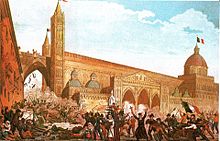| Sicilian revolution of 1848 | |||||||
|---|---|---|---|---|---|---|---|
| Part of Revolutions of 1848 in the Italian states | |||||||
 The revolution in Palermo (12 January 1848) | |||||||
| |||||||
| Belligerents | |||||||
|
|
Supported by: | ||||||
| Commanders and leaders | |||||||
|
Ruggero Settimo V. Fardella di Torrearsa Francesco Crispi Ludwik Mierosławski |
Ferdinand II Carlo Filangieri | ||||||
| Units involved | |||||||
| Sicilian rebels | Army of the Two Sicilies | ||||||
| Strength | |||||||
| c. 20,000 | Unknown | ||||||
| Casualties and losses | |||||||
| Unknown | |||||||
The Sicilian revolution of independence of 1848 (Sicilian: Rivuluzzioni nnipinnintista siciliana dû 1848; Italian: Rivoluzione siciliana del 1848) which commenced on 12 January 1848 was the first of the numerous Revolutions of 1848 which swept across Europe.[1] It was a popular rebellion against the rule of Ferdinand II of the House of Bourbon, King of the Two Sicilies. Three revolutions against the Bourbon ruled Kingdom of the Two Sicilies had previously occurred on the island of Sicily starting from 1800: this final one resulted in an independent state (the self-proclaimed Kingdom of Sicily) which survived for 16 months. The Sicilian Constitution of 1848 which survived the 16 months was advanced for its time in liberal democratic terms, as was the proposal of a unified Italian confederation of states.[2] It was in effect a curtain-raiser to the end of the Bourbon kingdom of the Two Sicilies, finally completed by Giuseppe Garibaldi's Expedition of the Thousand in 1860, the Siege of Gaeta of 1860–1861 and the proclamation of the unified Kingdom of Italy.
- ^ La primavera dei popoli. La rivoluzione siciliana del 1848 (in Italian). Retrieved 16 September 2023.
- ^ "AUTONOMISMO E UNITÀ" (in Italian). Retrieved 16 September 2023.